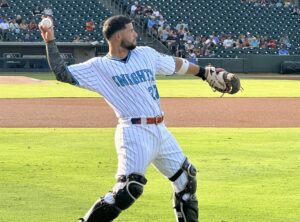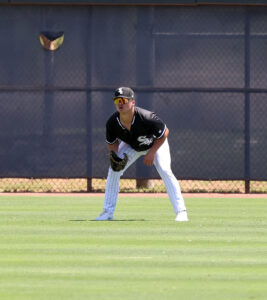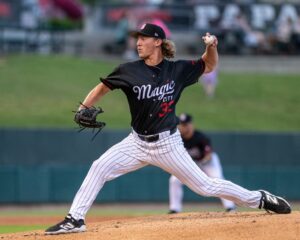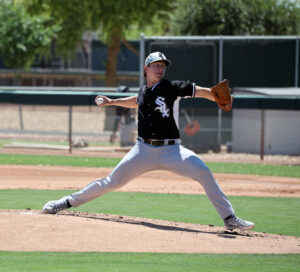Fieldside Chats: A conversation with Jonathan Stiever
Winston-Salem isn’t currently home to the sheer volume of top prospects as it was last year, when it saw Luis Robert, Nick Madrigal, Luis Basabe, Luis González, Micker Adolfo, Gavin Sheets, and more all play in the same lineup. This year’s roster isn’t quite so prospect-laden, but there are three players currently with the team who seem primed to succeed, not just at this level or the next two, but potentially all the way to the major leagues.
These are, of course, Andrew Vaughn, Jonathan Stiever, and Steele Walker. Stiever is up first in a three-part series talking to each of the Winston-Salem prospects.
Stiever’s stock on the mound has been rising meteorically since he was selected in the fifth round of last year’s draft and then promoted to Winston this year.

Stiever showed up wearing a Sox warmup shirt bearing the slogan, “Your best ability is your availability.” It’s a Sox philosophy, says Stiever.
“You can’t really help out if you’re not available,” Stiever said.
It’s about staying on the field and being prepared.
Stiever’s done both of those things in spades. In 14 starts for Kannapolis, Stiever didn’t display the dominance that he’s come to be known for with Winston-Salem. Most players do things the other way around — they’ll master a lower level, get the promotion, and struggle a little bit before adjusting to the new league. Stiever’s 4.74 ERA over 74 Low-A innings tells a misleading story, one that wasn’t backed by a 9.36 K/9 and 1.70 BB/9 rate at the level (tellingly, his FIP with Kannapolis was 3.88, nearly a full run lower than his ERA).
96 mph from Stiever for the strikeout @FutureSox pic.twitter.com/x9ca3Evo00
— Julie Brady (@DestroyBaseball) June 24, 2019
With the Dash, though, the results are there. Over 53 innings, he’s bumped his strikeout rate up to 10.70 K/9, while keeping his BB/9 exactly the same, in addition to giving up much fewer home runs than at the lower level. Stiever’s Dash ERA is 2.38, and that’s pretty close to his FIP of 2.69. So what’s the deal? Why is Stiever getting better as the competition gets harder?
“I think a lot of it has to do with sort of cleaning up my delivery here,” Stiever said. “I got a couple different drills from Matt Zaleski, the pitching coach, that’s helped out.
“A lot of it has to do with looking a little bit more at my sequencing of pitches and pitch selection. I wasn’t throwing my best pitches, I was kind of working on things that weren’t going to help me.”
Stiever says he looked at a lot more data once he arrived in Winston and was able to figure out which pitches worked for him.
“In what parts of the zone and to what hitters, right or lefty,” Stiever said.
In Winston, he’s been focusing more on pitching to his strengths. He’s also been using scouting reports much more often with the Dash. They were available in Kannapolis, but not emphasized.
“It was more just by eye and feeling yourself,” Stiever said.
But they’ve been helpful to Stiever in his resurgence, as he’s able to see what hitters have what weaknesses and being able to pitch to those. Overall, Stiever says, he’s working on different things in Winston and attacking hitters differently.
“I was getting ahead in Kannapolis, too, but I just wasn’t having success late in the count, which was kind of a problem here,” Stiever said. “I’ve been able to learn how to put guys away and basically set them up so late in the count, I can either get weak contact or stuff like that rather than end up giving up extra-base hits.”
The owner of a fastball that has run up to 98 mph, Stiever says that there’s been a little bit of a velocity increase (although he specifies that he doesn’t want to lose command at the expense of throwing harder).
“I’ve hit the numbers I have in the past, I haven’t done it as consistently,” he said. “I think that had to do with me cleaning up my delivery and direction to the plate. That was kind of the emphasis, the second I got here, that was what I worked on was cleaning up that delivery, going everything towards home plate rather than, I would get a little across my body sometimes.”
He said that he was able to watch video and see that when he was getting hit hard, he was throwing across his body, and cleaning up that mechanical issue has led to a lot of his current success.
His main pitch is the fastball, but as he said, he has a curve that complements it nicely.
“I can throw my curveball sort of as two different curveballs,” Stiever said. “I throw a harder one in the low 80s and then I’ll throw a little bit slower one depending on the matchup or what I’m trying to do with it.”
Right now, he’s working on his slider and changeup, but not the way he was in Kannapolis, when he says he was “trying to work on too many things at once.” Rather than trying to throw four average pitches, Stiever is focusing on the fastball and the curveball, “then sprinkling in the other two pitches that aren’t as far along.”
In Kannapolis, he would try to work on pitches in games and would end up getting shelled, so now, he’s able to pick his time to use them, in addition to a lot of bullpen work.
Stiever’s aware, vaguely, of his rising stock, but takes a realistic, level-headed approach to it.
“One month you can have good success, and then if you get sort of comfortable or anything it can unravel really quick,” he said.
Stiever said he takes every five days as a new five days, takes what he didn’t do well from the start and learns from that, what’s happening right now, rather than get caught up in broader scouting reports. Not that he’s not excited for the future, one that could possibly see him suiting up with other big-name rebuild pitchers like Michael Kopech and Dylan Cease.
“It’s a challenge you want to rise to,” Stiever said. “Those are great pitchers, and they’ve done a lot better and a lot more for the organization than I have—“ (“So far!”, I helpfully add) “—so I’m working my way there, so hopefully one day, you know, I can contribute at the big league level.”
One of the hallmarks of Stiever’s starts is the time he takes between pitches, or rather, the lack of time. He doesn’t circle the mound, play with the resin, or even shake his catcher off much.
“It’s getting in a groove,” he said. “It helps when you’re on the same page on the catcher. Going pregame and everything, establishing what you want to use to attack the certain lineup.”
He also shouts out the importance of getting in a groove with regard to his fielders.
“A lot of it has to do with the defense too,” Stiever said. “I know in college, that was kind of an emphasis we had, especially as a starter, just establish a rhythm to the game. It keeps the defense engaged. If it’s taking a long time, the defense can kind of sit back and they might not be as ready.
“If everything’s going smoothly, it’s easier to keep that rhythm. If things are going poorly, sometimes you have to take a step back and reset, and slow things down. So it’s a balance of working fast, but not getting so fast where you’re out of control … You want to take a deep breath and sort of assess the situation.”
Consider supporting FutureSox on Patreon! You can get early access to special articles and Patreon-only posts, in addition to more benefits you can read about here.





